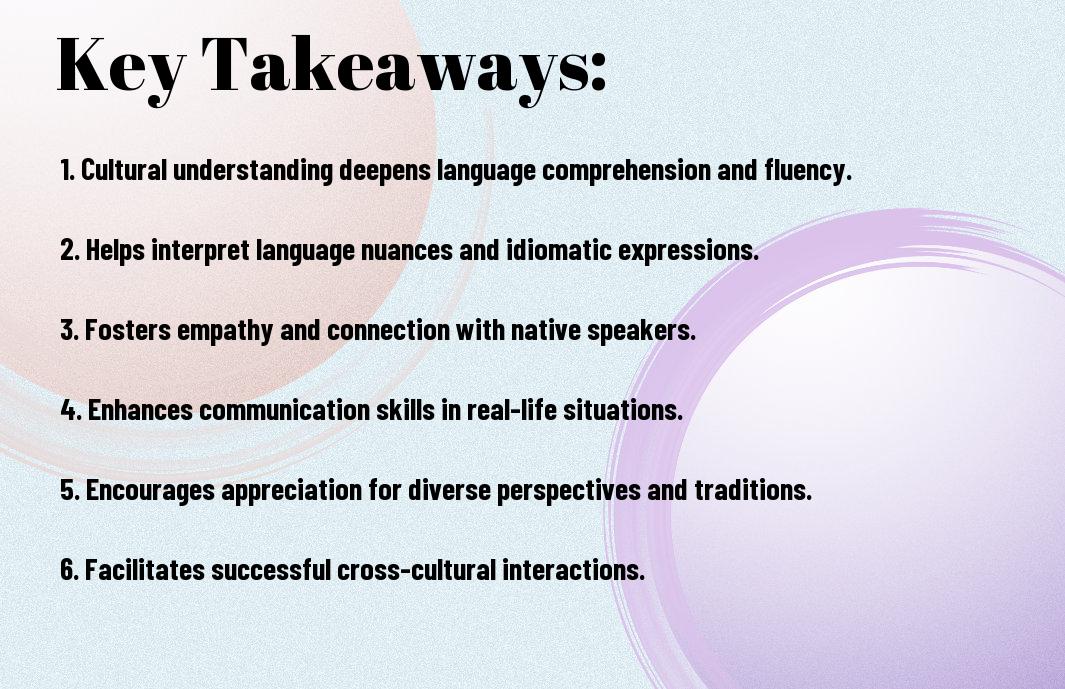You might wonder how expanding your cultural knowledge can actually improve your language learning experience. In this informative post, we will explore the fascinating connection between cultural understanding and language acquisition. Embracing different cultures not only enriches your overall learning journey but also provides valuable insights into the nuances and intricacies of a language. By delving into the cultural context behind the language, you can gain a deeper appreciation and comprehension of the language itself. Let’s dive in and discover the powerful impact of cultural understanding on your language learning endeavors.
Key Takeaways:
- Improved Communication: Cultural understanding can enhance language learning by providing context and depth to the language. This can help learners communicate more effectively and with increased cultural sensitivity.
- Increased Motivation: Learning about a culture can spark interest and motivation in language learners, making the learning process more engaging. Understanding cultural nuances can also make language learning more meaningful and enjoyable.
- Enhanced Language Proficiency: Cultural understanding can lead to a deeper understanding of the language’s idioms, expressions, and nuances. This can help learners achieve a higher level of proficiency and fluency in the language.

The Interconnectedness of Language and Culture
Language as a Reflection of Culture
To truly understand a language, you must research into the culture from which it stems. Language is not just a set of words strung together; it is a reflection of the values, beliefs, and societal norms of a particular group of people. When you learn a new language, you are not just memorizing vocabulary and grammar rules; you are gaining insight into the way a specific culture perceives the world around them. For example, the existence of different words to describe the same concept in various languages can reveal unique cultural perspectives and priorities.
Cultural Nuances in Language
Cultural nuances play a significant role in shaping language. Each culture has its own set of customs, traditions, and social cues, which are intricately woven into the language spoken by its people. Understanding these nuances is crucial for effective communication and language learning. For instance, the use of formal and informal language forms in many languages is a reflection of the hierarchical social structures present in those cultures.
Plus, recognizing cultural nuances in language can help you avoid misunderstandings and misinterpretations. For example, in some cultures, direct communication is valued, while in others, indirect communication is preferred. By being aware of these differences, you can adapt your language use accordingly and navigate intercultural interactions more smoothly.

Breaking Down Barriers
It is crucial to break down cultural barriers in language learning to fully embrace and understand a new language. Cultures greatly influence language, and having cultural awareness can significantly enhance your language learning experience. Understanding the cultural context behind a language can help you navigate nuances and expressions that may not directly translate.
Overcoming Stereotypes and Preconceptions
When learning a new language, it is crucial to overcome stereotypes and preconceptions that you may hold about a particular culture. These biases can hinder your ability to fully immerse yourself in the language and understand its true meaning. By challenging these assumptions and being open-minded, you can create a more positive learning environment and deepen your cultural understanding. Explore more about Cultural Awareness in Language Learning.
| For | Embracing Cultural Differences |
Embracing Cultural Differences
Embracing cultural differences in language learning allows you to gain a deeper appreciation for the language and its origins. By immersing yourself in different cultural practices, traditions, and values, you can better understand the context in which the language is spoken. Embracing cultural differences also fosters empathy and respect for diverse perspectives, enriching your language learning journey.
To fully embrace cultural differences, you can engage in activities such as attending cultural events, watching films or reading literature from the target language’s culture, or even connecting with native speakers to learn more about their traditions and way of life.
The Power of Contextualization
Learning Language in Cultural Context
Not only does learning a language involve understanding grammar rules and vocabulary, but it also requires you to grasp the cultural context in which the language is used. By immersing yourself in the culture of the language you are trying to learn, you gain a deeper appreciation for the nuances and subtleties that are integral to effective communication.
Authentic Materials and Real-Life Examples
For a more enriched language learning experience, it is crucial to incorporate authentic materials and real-life examples into your studies. This could include watching movies, listening to music, reading books, or engaging in conversations with native speakers. These real-world applications help you understand how the language is used in everyday situations, making your learning more practical and dynamic.
Context plays a vital role in language acquisition as it helps you see the language in action, bringing it to life beyond just words on a page. By contextualizing your learning, you connect with the language on a deeper level, making it more meaningful and memorable.
Powerful learning happens when you engage with authentic materials and real-life examples, as they provide you with a direct link to the culture and language you are studying. This firsthand exposure allows you to pick up nuances, idiomatic expressions, and cultural references that are crucial for effective communication. By incorporating authentic materials into your language learning journey, you not only improve your language skills but also gain a deeper understanding and appreciation of the culture that shapes the language.
Enhancing Comprehension through Cultural Insight
Once again, cultural understanding plays a vital role in enhancing your language learning journey. By delving deeper into a culture, you gain valuable insights that help you comprehend the language in a more profound way. This deeper comprehension goes beyond just grammar and vocabulary, allowing you to grasp the nuances of the language through cultural context.
Idioms, Proverbs, and Figurative Language
Insight into a culture provides you with the key to unraveling the mysteries of idioms, proverbs, and figurative language. These elements are deeply rooted in the cultural beliefs, practices, and history of a society. By understanding the cultural context behind these expressions, you not only improve your language skills but also gain a deeper appreciation for the culture itself.
Cultural References and Allusions
Cultural references and allusions are scattered throughout a language, enriching its vocabulary with layers of meaning that can be easily missed if you are not familiar with the culture. By immersing yourself in the culture, you become attuned to these references, allowing you to grasp the full implications of a word or phrase. This heightened awareness enhances your language comprehension and enables you to communicate more effectively.
Incorporating cultural references and allusions into your language learning journey adds depth to your understanding and proficiency. It allows you to connect more intimately with the language, enabling you to have more meaningful interactions and convey your thoughts and emotions with greater precision.
Building Empathy and Connection
Unlike simply learning vocabulary and grammar, cultural understanding in language learning helps you develop empathy and connection with others. According to a study on Why Learning a New Language Improves Tolerance, acquiring a new language can enhance your ability to understand different perspectives and viewpoints, leading to increased tolerance and acceptance of diverse cultures.
Perspective-Taking and Active Listening
An crucial aspect of cultural understanding is the ability to engage in perspective-taking and active listening. By immersing yourself in the language and culture of another community, you learn to see the world through their eyes, which fosters empathy and helps you form deeper connections with individuals from different backgrounds.
Fostering Cross-Cultural Relationships
To truly excel in language learning and cultural understanding, it’s crucial to embrace the opportunity to foster cross-cultural relationships. By engaging with native speakers, participating in cultural events, and embracing local traditions, you not only enhance your language skills but also develop meaningful connections that transcend linguistic barriers. Embracing diversity and actively seeking to understand and appreciate different cultures will enrich your language learning journey and broaden your worldview.
Empathy and connection are at the core of cultural understanding, and through language learning, you can cultivate a deeper appreciation for diverse perspectives and forge meaningful relationships with people from all walks of life.

Cultural Competence in Language Instruction
Despite the importance of cultural competence in language instruction, it is often an aspect that is overlooked. However, incorporating cultural elements into language teaching can greatly enhance the learning experience for students.
Teacher Training and Cultural Awareness
To ensure cultural understanding enhances language learning, it is crucial for language teachers to undergo training that emphasizes cultural awareness. Teachers who are culturally aware can create a more inclusive and engaging environment for students from diverse backgrounds. By understanding the cultural nuances of the language being taught, educators can provide a richer learning experience that goes beyond grammar and vocabulary.
Incorporating Cultural Elements in Lesson Plans
Lesson plans that integrate cultural elements can make language learning more meaningful and relevant. By including cultural references, traditions, and practices in lessons, students can better connect with the language and develop a deeper appreciation for the culture. This approach not only improves language retention but also fosters a sense of cultural empathy and understanding among learners.
Awareness
By prioritizing cultural competence in language instruction, you can create a more immersive and impactful learning experience for students. Embracing cultural diversity in the classroom not only enhances language learning but also promotes empathy, tolerance, and global awareness among learners. As an educator, you have the power to shape a culturally rich and inclusive learning environment that prepares students to thrive in an interconnected world.
Conclusion
From above, you can see that cultural understanding plays a crucial role in enhancing language learning. By immersing yourself in the culture of the language you are learning, you not only gain a deeper appreciation for the language but also develop a better understanding of its nuances and complexities. This deep level of cultural understanding can significantly improve your language skills and make the learning process more enjoyable and meaningful.
Furthermore, when you take the time to learn about the customs, traditions, and history of a culture, you are better equipped to communicate effectively with native speakers and build stronger connections with them. This cultural insight can help you navigate conversations more confidently, avoid misunderstandings, and develop a true appreciation for the language you are learning. In essence, cultural understanding enriches your language learning experience and empowers you to become a more proficient and culturally sensitive communicator.
FAQ
Q: How does cultural understanding enhance language learning?
A: Understanding the culture of the language you are learning helps you grasp the nuances and context of the language better. It provides insight into the customs, traditions, and social norms that influence the language’s usage.
Q: What are the benefits of incorporating cultural understanding in language learning?
A: By incorporating cultural understanding, language learners can become more proficient in communication by understanding the cultural references, idioms, and non-verbal cues that are integral to effective language use. It also promotes empathy, respect, and appreciation for different cultures.
Q: How can learners improve their cultural understanding while learning a new language?
A: Learners can improve their cultural understanding by immersing themselves in the culture through activities such as watching movies, reading books, listening to music, trying traditional foods, and interacting with native speakers. Joining cultural exchange programs and studying abroad are also effective ways to deepen cultural understanding.



